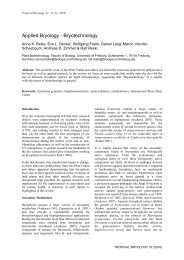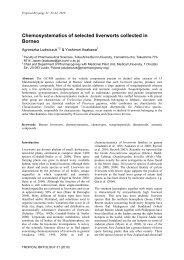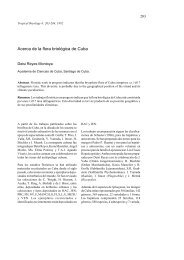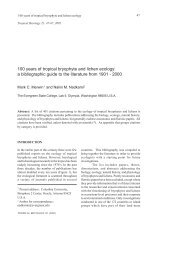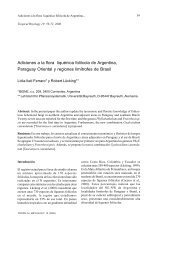Las comunidades de briófitos y su relacion con ... - Tropical Bryology
Las comunidades de briófitos y su relacion con ... - Tropical Bryology
Las comunidades de briófitos y su relacion con ... - Tropical Bryology
You also want an ePaper? Increase the reach of your titles
YUMPU automatically turns print PDFs into web optimized ePapers that Google loves.
<strong>Las</strong> <strong>comunida<strong>de</strong>s</strong> <strong>de</strong> <strong>briófitos</strong>.....<br />
<strong>Tropical</strong> <strong>Bryology</strong> 24: 101-113, 2003<br />
<strong>Las</strong> <strong>comunida<strong>de</strong>s</strong> <strong>de</strong> <strong>briófitos</strong> y <strong>su</strong> <strong>relacion</strong> <strong>con</strong> la estructura <strong>de</strong><br />
la vegetaticón fanerogamica, en el gradiente altitudinal <strong>de</strong> la<br />
Serranía <strong>de</strong>l Perijá (Cesar – Colombia)<br />
Cesar Augusto Ruiz Agu<strong>de</strong>lo<br />
Instituto <strong>de</strong> Ciencias Naturales-Universidad Nacional <strong>de</strong> Colombia. Apartado aéreo 7495,<br />
Bogotá, D.C. Colombia. cesarruiz1@excite.com<br />
Jaime Aguirre Ceballos<br />
Instituto <strong>de</strong> Ciencias Naturales-Universidad Nacional <strong>de</strong> Colombia. Programa <strong>de</strong> Doctorado<br />
en Biología- Línea <strong>de</strong> Biodiversidad y Conservación. Apartado aéreo 7495, Bogotá, D.C.<br />
Colombia.<br />
Jaguirre@ciencias.ciencias.unaledu.co<br />
Re<strong>su</strong>men: De la Serranía <strong>de</strong>l Perijá (Cesar-Colombia), a lo largo <strong>de</strong>l gradiente altitudinal se <strong>de</strong>scriben<br />
cinco <strong>comunida<strong>de</strong>s</strong> <strong>de</strong> <strong>briófitos</strong> (dos en las franjas <strong>su</strong>bandina baja – tropical y tres en las franjas<br />
<strong>su</strong>bandina baja-alta) cuyas características <strong>de</strong>pen<strong>de</strong>n <strong>de</strong> factores como el clima (humedad e intensidad<br />
lumínica), la estructura y la composición <strong>de</strong> la vegetación <strong>su</strong>perior. Los análisis se realizaron<br />
siguiendo los lineamientos <strong>de</strong> la escuela Braun-Blanquetiana y la aplicación <strong>de</strong>l Twinspan. A<strong>de</strong>más,<br />
se analizan <strong>su</strong>s formas <strong>de</strong> crecimiento en todas las franjas altitudinales, las más comunes son felpas<br />
lisas, felpas rugosas e hilos.<br />
Abstract: A long the altitudinal gradient of Serranía <strong>de</strong>l Perijá (Cesar-Colombia) five communities<br />
of Bryophytes were <strong>de</strong>scribed (two of these communities in the <strong>su</strong>bandina low – tropical belt and<br />
three in the <strong>su</strong>ban<strong>de</strong>an low-high belt). Characteristics of these communities <strong>de</strong>pend of factors <strong>su</strong>ch<br />
as the climate (humidity and light intensity), structure and composition on the fanerogamic<br />
vegetation. Statistical analysis followed the Braun-Blanquet school using Twinspan software. In all<br />
the altitudinal zones forms growth more common are smooth mats, rough mats, and threads.<br />
TROPICAL BRYOLOGY 24 (2003)<br />
101
102<br />
Introducción<br />
Los análisis <strong>de</strong> la vegetación criptogámica han<br />
tenido una larga trayectoria en las zonas<br />
templadas <strong>con</strong> <strong>de</strong>scripciones cuantitativas <strong>de</strong><br />
<strong>comunida<strong>de</strong>s</strong> <strong>de</strong> <strong>briófitos</strong> epífitos <strong>de</strong> estas<br />
regiones (Barkman 1958, Hale 1955, Iwat<strong>su</strong>ki<br />
1960, Pike et al 1975, Sjögren 1961, Wilmanns<br />
1962). Richards (1954, 1991) <strong>de</strong>scribió un<br />
número importante <strong>de</strong> <strong>comunida<strong>de</strong>s</strong> para los<br />
bosques <strong>de</strong> Guyana. Descripciones recientes y<br />
<strong>de</strong>talladas <strong>de</strong> <strong>comunida<strong>de</strong>s</strong> <strong>de</strong> <strong>briófitos</strong> se<br />
encuentran en Cornelissen & Steege (1989) y<br />
Montfoort & Ek (1990), también para Guyana y<br />
Guyana Francesa.<br />
Wolf (1993) <strong>de</strong>scribió las <strong>comunida<strong>de</strong>s</strong><br />
(montano bajas y montano altas) <strong>de</strong> epífitos no<br />
vasculares en un transecto altitudinal en el norte<br />
<strong>de</strong> los An<strong>de</strong>s <strong>de</strong> Colombia, analizó variables<br />
ambientales como intensidad <strong>de</strong> luz y grado <strong>de</strong><br />
humedad.<br />
Contribuciones sobre la distribución <strong>de</strong> <strong>briófitos</strong><br />
epífitos han tenido mayor énfasis en las zonas<br />
templadas y <strong>su</strong>btropicales (Barkman 1958,<br />
Iwat<strong>su</strong>ki 1960, Pike et al 1975, Slack 1976,<br />
Smith 1982 , Studlar 1982, Beever 1984). En<br />
<strong>con</strong>traste, los aportes en los bosques tropicales,<br />
incluidos los <strong>de</strong> tierras bajas, son reducidos<br />
(Cornelissen & Steege 1989).<br />
Los <strong>briófitos</strong> epífitos se han estudiado <strong>de</strong> acuerdo<br />
<strong>con</strong> <strong>su</strong> distribución vertical <strong>de</strong>s<strong>de</strong> la base <strong>de</strong>l<br />
forofito hasta el dosel y la distribución<br />
horizontal, relación entre forofito y epífito<br />
(Cornelissen & Steege 1989).<br />
La distribución vertical ha sido tratada por<br />
Richards (1954, 1984), Florschutz-<strong>de</strong> Waard &<br />
Bekker (1987). Pócs (1982) propuso cuatro<br />
hábitats o zonas según la altura <strong>de</strong>l forofito (base,<br />
tronco, ramas bajas y ramas terminales) y<br />
<strong>con</strong>cluye que la composición <strong>de</strong> especies y<br />
formas <strong>de</strong> vidas <strong>de</strong> estos hábitats es muy similar<br />
en los bosques tropicales. Cornelissen y Steege<br />
(1989), propusieron seis zonas según la altura<br />
<strong>de</strong>l forofito (base- en el <strong>su</strong>elo-, tronco bajomenos<br />
<strong>de</strong> dos metros <strong>de</strong>l <strong>su</strong>elo-, tronco alto- más<br />
<strong>de</strong> dos metros <strong>de</strong>l <strong>su</strong>elo-, ramas bajas-primeras<br />
Ruiz & Aguirre<br />
ramas <strong>de</strong>l árbol-, ramas medias y ramas<br />
terminales-que hacen parte <strong>de</strong>l dosel-) y<br />
dividieron las preferencias <strong>de</strong> las especies <strong>de</strong><br />
<strong>briófitos</strong> epífitos en „Especialistas“ (especies que<br />
presentan un estrecho margen <strong>de</strong> distribución en<br />
diferentes hábitats, <strong>con</strong> el 90% <strong>de</strong> los registros<br />
para uno o máximo dos hábitats) y „Generalistas“<br />
(especies <strong>con</strong> un amplio rango <strong>de</strong> distribución<br />
en los diferentes hábitats).<br />
Como se observa , las <strong>con</strong>tribuciones hasta la<br />
fecha publicadas no se ocupan <strong>de</strong> la posible<br />
relación <strong>de</strong> <strong>comunida<strong>de</strong>s</strong> <strong>de</strong> briofitos y<br />
<strong>comunida<strong>de</strong>s</strong> <strong>de</strong> fanerogamas. En algunos casos<br />
se insinúa <strong>su</strong> posible relación, pero nunca se ha<br />
analizado <strong>con</strong> mayor profundidad.<br />
En la presente <strong>con</strong>tribución se <strong>de</strong>scriben las<br />
<strong>comunida<strong>de</strong>s</strong> <strong>de</strong> <strong>briófitos</strong> y <strong>su</strong> relación <strong>con</strong> los<br />
tipos <strong>de</strong> vegetación vascular en don<strong>de</strong> se<br />
establecen, a lo largo <strong>de</strong>l gradiente altitudinal<br />
<strong>de</strong> la Serranía <strong>de</strong>l Perijá (Cesar – Colombia).<br />
A<strong>de</strong>más, se analizan las formas <strong>de</strong> crecimiento<br />
<strong>de</strong> los <strong>briófitos</strong> en dichas <strong>comunida<strong>de</strong>s</strong>.<br />
METODOLOGÍA<br />
La <strong>de</strong>scripción base <strong>de</strong>l enfoque se encuentra<br />
en Aguirre & Ruiz (2001).<br />
Para <strong>de</strong>finir las <strong>comunida<strong>de</strong>s</strong> <strong>de</strong> <strong>briófitos</strong> se<br />
utilizó el programa Twinspan (Hill 1979); las<br />
tablas finales se organizaron manualmente y se<br />
or<strong>de</strong>naron siguiendo los lineamientos <strong>de</strong> la<br />
escuela Sigmatista. (Braun–Blanquet 1979).<br />
En los análisis <strong>de</strong> las <strong>comunida<strong>de</strong>s</strong> se incluyeron<br />
los taxa que se <strong>de</strong>terminaron al nivel <strong>de</strong> especie.<br />
Especies <strong>de</strong> los géneros Plagiochila y Lejeunea,<br />
no se incluyen en los análisis.<br />
La presencia, cobertura y preferencia <strong>de</strong> las<br />
especies <strong>de</strong> <strong>briófitos</strong> sobre los diferentes tipos<br />
<strong>de</strong> habitats (zonificación, base <strong>de</strong> tronco a dosel)<br />
se estudió según Cornelissen y Steege (1989).<br />
El estudio <strong>de</strong> las formas <strong>de</strong> crecimiento se realizó<br />
<strong>de</strong> acuerdo <strong>con</strong> Mäg<strong>de</strong>frau (1982), Studlar<br />
(1982), Richards (1984), Cornelissen & Steege<br />
(1989) y Churchill & Linares (1995). Para la<br />
zona <strong>de</strong> estudio se tomaron en cuenta las<br />
TROPICAL BRYOLOGY 24 (2003)
<strong>Las</strong> <strong>comunida<strong>de</strong>s</strong> <strong>de</strong> <strong>briófitos</strong>.....<br />
siguientes: Cespitosas bajas (Cc), Cespitosas<br />
altas (Ca), Cojines (Coj), Hilos o fibras (Hi),<br />
Felpas lisas (Fl), Felpas rugosas (Fr),<br />
Horizontales (H), Taloi<strong>de</strong>s (T), Péndulas (P),<br />
Dendroi<strong>de</strong>s no dorsiventrales (A) y Formas<br />
<strong>de</strong>lgadas (B).<br />
RESULTADOS Y DISCUSIÓN<br />
Análisis <strong>de</strong> la vegetación (Tabla 1): Se<br />
<strong>de</strong>finieron cinco <strong>comunida<strong>de</strong>s</strong> <strong>de</strong> <strong>briófitos</strong> para<br />
la región <strong>de</strong>l Perijá (Tabla 1), distribuidas en dos<br />
grupos <strong>de</strong> acuerdo <strong>con</strong> la altitud: A)- Compuesto<br />
por dos <strong>comunida<strong>de</strong>s</strong> (1 y 5), por <strong>de</strong>bajo <strong>de</strong>l nivel<br />
<strong>de</strong> los 1500 m (franja <strong>su</strong>bandina baja y tropical)<br />
y B)- Integrado por tres <strong>comunida<strong>de</strong>s</strong> (2, 3 y 4)<br />
entre los 1000 y 2000 m (franjas <strong>su</strong>bandina baja<br />
y alta). La diferenciación obtenida en grupos <strong>de</strong><br />
<strong>comunida<strong>de</strong>s</strong> por rangos altitudinales, es similar<br />
a los valores obtenidos por Grubb (1974) y Wolf<br />
(1993).<br />
Especies <strong>de</strong> amplia distribución (Tabla 1):<br />
Comunes en todo el gradiente altitudinal y<br />
presentes en todas las <strong>comunida<strong>de</strong>s</strong> <strong>de</strong><br />
<strong>briófitos</strong> <strong>de</strong>scritas.<br />
Lophocolea bi<strong>de</strong>ntata, Syrrhopodon prolifer,<br />
Telaranea nemato<strong>de</strong>s y Metzgeria <strong>de</strong>cipiens<br />
son <strong>de</strong> amplia distribución, <strong>con</strong> valores <strong>de</strong><br />
presencia y cobertura que oscilan entre 20-3.8 a<br />
100-28.3 %. Estas especies presentan diversos<br />
tipos <strong>de</strong> formas <strong>de</strong> crecimiento, entre ellas hilos<br />
(Hi), la más común en los bosques tropicales<br />
(Cornelissen & Steege 1989); a<strong>de</strong>más, son<br />
generalistas, <strong>con</strong> los mayores valores <strong>de</strong><br />
frecuencia en los hábitats base <strong>de</strong> tronco y<br />
corteza.<br />
Vegetación criptogámica <strong>de</strong> la región<br />
Subandina baja y <strong>Tropical</strong> (
104<br />
cobertura en la comunidad. De las 5 especies<br />
acompañantes, Calymperes lonchophyllum (50%<br />
presencia–50% cobertura) y Thuidium<br />
peruvianum (50%-50%) presentan los mayores<br />
valores <strong>de</strong> presencia y cobertura.<br />
Ecología y distribución: Entre 580 m (Franja<br />
tropical) y 1230 m (Franja <strong>su</strong>bandina baja) <strong>con</strong><br />
preferencia a 1230 m (mayores valores <strong>de</strong><br />
presencia y cobertura). Se establece en varios<br />
tipos <strong>de</strong> vegetación fanerogámica, <strong>de</strong>s<strong>de</strong> los<br />
bosquetes residuales <strong>de</strong> las orillas <strong>de</strong> las<br />
quebradas secas y colinas pedregosas, hasta los<br />
bosques altos entresacados <strong>de</strong> los terrenos planos<br />
en la parte alta. <strong>Las</strong> especies dominantes son<br />
Mauria <strong>su</strong>aveolens, Anthurium fendleri, Ocotea<br />
sp., Olmedia sp., Polypodium sp., Pouteria sp.,<br />
Vitis tiliaefolia (Arellano 2001).<br />
Los taxa que hacen parte <strong>de</strong> la comunidad<br />
prefirieron los hábitats: base <strong>de</strong> tronco, corteza<br />
baja y troncos caídos <strong>de</strong>scompuestos, presentan<br />
los mayores valores <strong>de</strong> presencia y cobertura en<br />
base <strong>de</strong> tronco. El 90 % <strong>de</strong> las especies son<br />
generalistas. Macrocoma tenue (troncos caídos<br />
<strong>de</strong>scompuestos) y Thuidium peruvianum (base<br />
<strong>de</strong> tronco) son especialistas <strong>de</strong> un hábitat. En la<br />
comunidad predominan las formas <strong>de</strong><br />
crecimiento felpas lisas (Fl), felpas rugosas (Fr)<br />
y cespitosas bajas (Cc).<br />
<strong>Las</strong> características <strong>de</strong> la vegetación <strong>de</strong><br />
fanerógamas (bosquete residual <strong>de</strong> baja<br />
cobertura) permiten el establecimiento <strong>de</strong><br />
<strong>comunida<strong>de</strong>s</strong> como ésta, que se ubica en base<br />
<strong>de</strong> troncos y hábitats protegidos (que <strong>con</strong>servan<br />
más humedad) en don<strong>de</strong> dominan las formas <strong>de</strong><br />
crecimiento postradas y cortas. Estos re<strong>su</strong>ltados<br />
<strong>con</strong>cuerdan <strong>con</strong> las <strong>con</strong>si<strong>de</strong>raciones <strong>de</strong> Birse<br />
(1957), sobre las formas que dominan en<br />
<strong>con</strong>diciones <strong>de</strong> baja humedad y alta intensidad<br />
<strong>de</strong> luz.<br />
Vegetación criptogámica <strong>de</strong> la región<br />
Subandina. franja alta y baja (>1000 y 2000<br />
m) (Tabla 1)<br />
Comunidad <strong>de</strong> Calypogeia miqueli –<br />
Phyllogonium fulgens<br />
Ruiz & Aguirre<br />
Composición: La <strong>con</strong>stituyen 45 especies (22<br />
hepáticas y 23 musgos). <strong>Las</strong> exclusivas son:<br />
Phyllogonium fulgens, Calypogeia miqueli,<br />
Bazzania gracilis, Octoblepharum cocuiensi,<br />
Isodrepanium lentulum y Pallavicina lyelli. Se<br />
diferencian 5 especies electivas <strong>de</strong> las cuales<br />
Pyrrhobryum spiniforme (100% presencia y<br />
20.7% cobertura) y Lepidopilum scabrisetum<br />
(100%–19%) presentan los mayores valores <strong>de</strong><br />
presencia y cobertura. De las 34 especies<br />
acompañantes, Lejeunea flava y Rhacopilopsis<br />
trinitensis son las más representativas.<br />
Ecología y distribución: La comunidad se<br />
encuentra entre 1580 m y 1820 m <strong>con</strong><br />
preferencia a 1820 m (mayores valores <strong>de</strong><br />
presencia y cobertura). Se establece en<br />
vegetación fanerogámica <strong>de</strong> tipo selva<br />
multiestratificada <strong>de</strong> la franja <strong>su</strong>bandina, <strong>con</strong> un<br />
estrato arbóreo <strong>su</strong>perior poco <strong>de</strong>sarrollado don<strong>de</strong><br />
predominan Pouteria sp., Sloanea brevispina y<br />
Roupala montana. El estrato arbóreo inferior<br />
presenta coberturas <strong>de</strong>l 35-60% y se encuentra<br />
dominado por Sloanea brevispina, Icacinaceae<br />
sp., Pouteria sp., Eschweilera sp. y Guarea aff.<br />
glabra, entre otras. Chrysochlamys colombiana<br />
domina numéricamente en el estrato <strong>su</strong>b-arbóreo<br />
mientras que Nectandra megapodamica lo hace<br />
energéticamente. Otras especies como Mikania<br />
banisteriae, Chamaedorea pinnatifrons,<br />
Guatteria carga<strong>de</strong>ro, Burseraceae sp. y Guarea<br />
sp. presentan altos índices <strong>de</strong> dominancia para<br />
el estrato (Arellano 2001).<br />
En este tipo <strong>de</strong> vegetación fanerogámica, la<br />
comunidad prefiriere los hábitats base <strong>de</strong> tronco,<br />
corteza baja y troncos caídos <strong>de</strong>scompuestos,<br />
presentando los mayores valores <strong>de</strong> presencia y<br />
cobertura en corteza baja.<br />
En las especies que hacen parte <strong>de</strong> la comunidad<br />
(Tabla 1), predominan las formas <strong>de</strong> crecimiento<br />
felpas lisas (Fl), felpas rugosas (Fr) e hilos (Hi).<br />
Están también cojines (Coj), cespitosas altas<br />
(Ca), cespitosas bajas (Cc) y <strong>de</strong>ndroi<strong>de</strong>s no<br />
dorsiventrales (A). Estas formas indican que las<br />
<strong>con</strong>diciones que brinda la vegetación <strong>de</strong><br />
fanerógamas (un bosque multiestratificado <strong>con</strong><br />
mayores porcentajes <strong>de</strong> cobertura) permiten<br />
mayor retención <strong>de</strong> humedad (Barkman 1958)<br />
TROPICAL BRYOLOGY 24 (2003)
<strong>Las</strong> <strong>comunida<strong>de</strong>s</strong> <strong>de</strong> <strong>briófitos</strong>.....<br />
favoreciendo estas formas erectas o semierectas<br />
(Birse 1957).<br />
Esta comunidad cuenta <strong>con</strong> un mayor número<br />
<strong>de</strong> especies acompañantes; es <strong>de</strong> esperar que un<br />
bosque complejo (mixto) ofrece mayor<br />
diversidad <strong>de</strong> hábitats y por lo tanto se favorece<br />
la ocurrencia <strong>de</strong> más especies (Gradstein et al.,<br />
1990).<br />
Comunidad <strong>de</strong> Shymphyogyna aspera-<br />
Shymphyogyna brogniarti<br />
Composición: La integran 69 especies (28<br />
hepáticas y 41 musgos). <strong>Las</strong> exclusivas (4) son:<br />
Symphyogyna aspera, Symphyogyna brogniarti,<br />
Metzgeria maeg<strong>de</strong>fraui e Isotachys multiceps.<br />
Se diferencian 13 especies electivas <strong>de</strong> las cuales<br />
Thuidium tomento<strong>su</strong>m (83% presencia y 8.3%<br />
cobertura) e Hypopterygium tamariscinum<br />
(66%–14.45%) presentan los mayores valores <strong>de</strong><br />
presencia y cobertura.<br />
De las 52 especies acompañantes,<br />
Sematophyllum <strong>su</strong>bpinnatum, Mittenathamnium<br />
reptans y Neckeropsis undulata presentan los<br />
mayores valores <strong>de</strong> presencia y cobertura. Son<br />
comunes especies <strong>de</strong> los géneros Plagiochila ,<br />
Lejeunea y algunas Parmeliaceas.<br />
Ecología y distribución: La comunidad se<br />
encuentra entre 1200 m y 1820 m <strong>con</strong><br />
preferencia a 1720-1810m (mayores valores <strong>de</strong><br />
presencia y cobertura). Se establece en<br />
vegetación fanerogámica <strong>de</strong> tipo selva<br />
multiestratificada <strong>su</strong>bandina, <strong>con</strong> elementos<br />
como Billia rosea, Ficus cuatrecasae y Guarea<br />
kunthiana en el estrato arbóreo <strong>su</strong>perior, <strong>con</strong><br />
promedios <strong>de</strong> 30 y 31 m <strong>de</strong> altura y coberturas<br />
<strong>de</strong>l 35-65%. En este estrato existe un marcado<br />
predominio fisionómico y numérico <strong>de</strong> G.<br />
kunthiana. El estrato arbóreo inferior está<br />
dominado por Prunus integrifolia y Ficus<br />
cuatrecasae seguidos <strong>de</strong> Persea sp.,<br />
Machaerium sp. y Nectandra sp. En los estratos<br />
<strong>su</strong>b-arbóreo y arbustivo dominan Piper medium,<br />
Parathesis a<strong>de</strong>nanthera, Persea sp. y Ficus sp.<br />
<strong>con</strong> algunas variaciones <strong>de</strong> posición <strong>de</strong>ntro <strong>de</strong><br />
éstos. Se en<strong>con</strong>traron especies epífitas como<br />
Peperomia tetraphylla, Pleurothallis sp.,<br />
Tillandsia complanata, Govenia sp. y trepadoras<br />
como Amphilophium paniculatum, Blepharodon<br />
TROPICAL BRYOLOGY 24 (2003)<br />
105<br />
sp., Convolvulaceae sp., Fevillea cordifolia,<br />
Macfadyena unguis-cati, Malvaviscus elegans y<br />
Mikania banisteriae (Arellano 2001).<br />
Esta comunidad se establece en tipos <strong>de</strong><br />
vegetación fanerogámica similares<br />
(estructuralmente) a los <strong>de</strong> la comunidad <strong>de</strong><br />
Calypogeia miqueli-Phyllogonium fulgens. <strong>Las</strong><br />
especies <strong>de</strong> esta comunidad prefirieren los<br />
hábitats base <strong>de</strong> tronco, corteza baja y troncos<br />
caídos <strong>de</strong>scompuestos, <strong>con</strong> los mayores valores<br />
<strong>de</strong> presencia y cobertura en corteza baja. El 96%<br />
<strong>de</strong> las especies son generalista. Isotachys<br />
multiceps es exclusiva <strong>de</strong>l hábitat <strong>su</strong>elo (próximo<br />
a base <strong>de</strong> troncos). Predominan las formas <strong>de</strong><br />
crecimiento felpas lisas (Fl), felpas rugosas (Fr)<br />
e hilos (Hi).<br />
Están bien representadas las formas: cojines<br />
(Coj), cespitosas altas (Ca), cespitosas bajas<br />
(Cc), talosas (T) y <strong>de</strong>ndroi<strong>de</strong>s no dorsiventrales<br />
(A).<br />
Comunidad <strong>de</strong> Neckera scabri<strong>de</strong>ns – Papillaria<br />
nigrescens<br />
Composición: La <strong>con</strong>stituyen 74 especies (29<br />
hepáticas y 45 musgos). Son exclusivas Neckera<br />
scabri<strong>de</strong>ns, Papillaria nigrescens, Prionodon<br />
fusco-lutescens, Eurhynchium semiscabrum,<br />
Rhynchostegium serrulatum, Lopholejeunea<br />
nigricans, Papillaria impon<strong>de</strong>rosa, Fissi<strong>de</strong>ns<br />
serratus y Marchantia polymorpha. Se<br />
diferencian seis especies electivas <strong>de</strong> las cuales<br />
Prionodon <strong>de</strong>n<strong>su</strong>s (100% presencia y 9.86%<br />
cobertura) y Porotrichum lindigii (80% – 9.7%)<br />
presentan los mayores valores <strong>de</strong> presencia y<br />
cobertura.<br />
De las 59 especies acompañantes,<br />
Sematophyllum <strong>su</strong>bpinnatum (80% presencia–<br />
8.15% cobertura) y Mittenathamnium reptans<br />
(80%-7.65%) son las más representativas.<br />
Ecología y distribución: Esta comunidad es<br />
exclusiva <strong>de</strong> la región <strong>de</strong> vida <strong>su</strong>bandina alta.<br />
Se encuentra entre 1750 m y 2000 m <strong>con</strong><br />
preferencia a 1950 m (mayores valores <strong>de</strong><br />
presencia y cobertura). Se establece en<br />
vegetación fanerogámica <strong>de</strong> tipo selva<br />
<strong>su</strong>bandina, <strong>con</strong> cinco estratos bien diferenciados<br />
y <strong>con</strong> altos porcentajes <strong>de</strong> cobertura (45-65%).
106<br />
En el estrato arbóreo inferior el predominio<br />
fisionómico es <strong>de</strong> Ficus sp. y Nectandra sp.<br />
seguidos por Prunus integrifolia, Persea<br />
caerulea e Inga minutula. El estrato <strong>su</strong>b-arbóreo,<br />
se encuentra dominado fisionómicamente por<br />
Guettarda sp. y Piper lanceaefolium, aunque,<br />
en los valores <strong>de</strong> dominancia numérica<br />
predominan Piper lanceaefolium e Inga<br />
minutula. Se registraron, a<strong>de</strong>más especies<br />
epifitas como Vriezea incurva, Mikania sp.,<br />
Pleurothallis sp., Cinanchum tenellum y<br />
Rhipsalis baccifera (Arellano 2001).<br />
En este tipo <strong>de</strong> vegetación fanerogámica, la<br />
comunidad prefiriere los hábitats base <strong>de</strong> tronco<br />
y corteza baja. Están bien representados troncos<br />
caídos <strong>de</strong>scompuestos, ramas bajas y <strong>su</strong>elo<br />
(próximo a las bases <strong>de</strong> tronco). El 98 % <strong>de</strong> las<br />
especies son generalistas en cuanto <strong>su</strong><br />
preferencia a hábitats.<br />
<strong>Las</strong> formas <strong>de</strong> crecimiento que dominan en las<br />
especies que <strong>con</strong>stituyen la comunidad son felpas<br />
lisas (Fl), felpas rugosas (Fr), formas péndulas<br />
(P), <strong>de</strong>ndroi<strong>de</strong>s no dorsiventrales (A) y formas<br />
<strong>de</strong>lgadas (B). La abundancia <strong>de</strong> formas péndulas<br />
y <strong>de</strong>ndroi<strong>de</strong>s no dorsiventrales indica que las<br />
<strong>con</strong>diciones que brinda la vegetación <strong>de</strong><br />
fanerógamas (bosques multiestratificados <strong>con</strong><br />
buena humedad y porcentajes altos <strong>de</strong> cobertura)<br />
permiten mayor retención <strong>de</strong> humedad y<br />
favorecen el epifitismos <strong>de</strong> ramas y porciones<br />
<strong>de</strong>l árbol más altas (por ejemplo la especie<br />
Neckera scabri<strong>de</strong>ns <strong>de</strong> habito péndulo<br />
predomina en el hábitat ramas bajas).<br />
El establecimiento <strong>de</strong> esta comunidad en el límite<br />
<strong>de</strong> las regiones <strong>de</strong> vida <strong>su</strong>bandina alta y andina,<br />
<strong>con</strong> el mayor número <strong>de</strong> especies (74), corrobora<br />
que la diversidad <strong>de</strong> <strong>briófitos</strong> aumenta a medida<br />
que aumenta la altura sobre el nivel <strong>de</strong>l mar<br />
(Churchill & Linares 1995, Aguirre & Ruiz<br />
2001). Es claro que las características <strong>de</strong> las<br />
<strong>comunida<strong>de</strong>s</strong> <strong>de</strong> <strong>briófitos</strong> epífitos <strong>de</strong>pen<strong>de</strong> <strong>de</strong> los<br />
factores características <strong>de</strong>l bosque <strong>de</strong><br />
fanerógamas, humedad ambiental e intensidad<br />
<strong>de</strong> luz (Wolf 1993).<br />
Elementos atípicos: Se mencionan a<br />
<strong>con</strong>tinuación los elementos (levantamientos)<br />
Ruiz & Aguirre<br />
atípicos (aislados), que no hacen parte <strong>de</strong><br />
ninguna comunidad ya que <strong>su</strong> composición<br />
briflorística es muy distinta.<br />
Comunidad <strong>de</strong> Styrax aff.<br />
pseudoargyrophylla y Ocotea sp. (Fernán<strong>de</strong>z<br />
Jl. 13084): Municipio: Jagua <strong>de</strong> Ibirico, Alto <strong>de</strong><br />
las flores, Finca el Paraíso, Franja <strong>su</strong>bandina<br />
baja, (1020-1590), Altitud 1420 m –1580 m.<br />
La <strong>con</strong>stituyen 20 especies <strong>de</strong> <strong>briófitos</strong> (l1<br />
especies <strong>de</strong> musgos y nueve <strong>de</strong> hepáticas).<br />
Lepidopilum scabrisetum, Isopterygium<br />
tenerum, Pyrrhobryum spiniforme y Thuidium<br />
tomento<strong>su</strong>m presentan los mayores porcentajes<br />
<strong>de</strong> cobertura (25.0 a 26.0 %). Especies <strong>de</strong> los<br />
géneros Plagiochila, Lejeunea y Leptogium se<br />
encuentran bien representadas.<br />
Los <strong>briófitos</strong> se establecen en vegetación<br />
fanerogámica <strong>de</strong>l tipo selva multiestratificada <strong>de</strong><br />
la franja <strong>su</strong>bandina, <strong>con</strong> un estrato arbóreo<br />
<strong>su</strong>perior, don<strong>de</strong> dominan especies <strong>de</strong> Pouteria<br />
sp., Ocotea sp., Billia columbiana, Hirtella<br />
triandra y Sloanea brevispina entre otras, el cual<br />
presenta alturas promedio <strong>de</strong> 27 a 32 m y<br />
porcentajes medios <strong>de</strong> cobertura. En el estrato<br />
arbóreo inferior predominan Pouteria sp.,<br />
Heliocarpus aff. americanus, Billia rosea,<br />
Dendropanx arboreus e Hirtella triandra.<br />
Especies como Psychotria <strong>de</strong>flexa, Nectandra<br />
aff. acutifolia, Heliocarpus americanus,<br />
Dendropanax arboreus dominan el estrato <strong>su</strong>barbóreo,<br />
mientras que Ficus sp., Nectandra aff.<br />
acutifolia, Mauria <strong>su</strong>aveolens y Piper obliquum,<br />
lo hacen para el arbustivo (Arellano 2001).<br />
Asociación Piperimedium-Lozanelletum<br />
enantiophyllae<br />
Comunidad <strong>de</strong> Opuntia aff. schumanni y<br />
Xylosma obovatum : Agustín Codazzi, Vereda<br />
ara <strong>de</strong> Hombre, Finca Alsi<strong>de</strong>s, franja <strong>su</strong>bandina<br />
alta.(1600 a 2000 m). Altitud 1860 m.<br />
Syrrhopodon gaudichaudii y Fissi<strong>de</strong>ns<br />
asplenio<strong>de</strong>s, son las únicas especies <strong>de</strong> <strong>briófitos</strong>,<br />
<strong>con</strong> coberturas <strong>de</strong>l 25%. Estas especies <strong>de</strong><br />
<strong>briófitos</strong>, se establecen en vegetación<br />
fanerogámico <strong>de</strong> tipo Cardonal azonal,<br />
biestratificado, perteneciente a la franja<br />
TROPICAL BRYOLOGY 24 (2003)
<strong>Las</strong> <strong>comunida<strong>de</strong>s</strong> <strong>de</strong> <strong>briófitos</strong>.....<br />
<strong>su</strong>bandina, los estratos herbáceo y rasante<br />
presentan predominio fisionómico <strong>de</strong> Opuntia<br />
shumanni, Xylosma obovatum y Verbesina aff.<br />
lloensis. A<strong>de</strong>más, los estratos presentan valores<br />
<strong>de</strong> cobertura <strong>de</strong>l 10 al 15% (Arellano 2001).<br />
<strong>Las</strong> características que exhibe este tipo <strong>de</strong><br />
vegetación (cardonal), no favorecen el<br />
establecimiento y <strong>de</strong>sarrollo <strong>de</strong> las especies <strong>de</strong><br />
<strong>briófitos</strong>.<br />
Formas <strong>de</strong> crecimiento (Figura 1): Felpas lisas<br />
(FL, 39 especies) y felpas rugosas (Fr, 23<br />
especies) son las formas <strong>de</strong> crecimiento<br />
dominantes y las más exitosas en las <strong>con</strong>diciones<br />
ambientales (alta temperatura, alta intensidad <strong>de</strong><br />
luz y baja precipitación
108<br />
Braun-Blanquet, J. 1979. Fitosociología: bases para<br />
el estudio <strong>de</strong> las <strong>comunida<strong>de</strong>s</strong> vegetales. Ed.<br />
Blume, Madrid.<br />
Churchill, S.P. & E.L. Linares. 1995. Prodomus<br />
Bryologiae Novo-Granatensis.<br />
Introducción a la flora <strong>de</strong> musgos <strong>de</strong><br />
Colombia. Biblioteca José Jerónimo Triana.<br />
Tomos I y II. Instituto <strong>de</strong> Ciencias<br />
Naturales. Facultad <strong>de</strong> Ciencias.<br />
Universidad Nacional <strong>de</strong> Colombia.<br />
Bogotá.<br />
Cornelisen, J.H.C & H.T, Steege. 1989 . Distribution<br />
and ecology of epiphytic bryophytes and<br />
lichens in dry evergreen forest of Guyana.<br />
Journal of <strong>Tropical</strong> Ecology 5:131-150.<br />
Florscutz-<strong>de</strong> Waard, J. & J.M, Bekker. 1987. A<br />
comparative study of the bryophyte flora<br />
of different forest types in West Surinam.<br />
Cryptogamie, Bryologie Lichenologie<br />
8:31-45.<br />
Gradstein, S.R. 1995. Bryophyte diversity of the<br />
tropical rainforest. Archs. Sci. Geneve<br />
48(1):91-95.<br />
Gradstein, S.R., D. Montfoort & J.H.C.<br />
Cornelissen. 1990. Species richness and<br />
phytogeography of the bryophyte flora of<br />
the Guianas, with special reference to the<br />
lowland forest. <strong>Tropical</strong> <strong>Bryology</strong> 2:117-<br />
126.<br />
Grubb, P.J. 1974. Factors <strong>con</strong>trolling the distribution<br />
of forest-types on tropical mountains: new<br />
facts and a new perspectives. En. Flenley,<br />
J.R. (ed). Altitudinal zonation in Malesia.<br />
Univ. of Hull. Misc. Ser. 16:13-45.<br />
Hale, M.E. 1955. Phytosociology of corticolous<br />
cryptogams in the upland forest of southern<br />
Wis<strong>con</strong>sin. Ecology 36:4563.<br />
Hill, M.O. 1979. TWINSPAN. A FORTRAN<br />
program for arranging multivariate data in<br />
a or<strong>de</strong>red two-way table by classification<br />
of the individuals and attributes. Cornell<br />
University, Ithaca.<br />
Iwat<strong>su</strong>ki, Z. 1960. The epiphytic bryophyte<br />
communities in Japan. Journal Hattori<br />
Botanical Laboratory 22: 159-348.<br />
Kürschner, H. 1990. Die epiphytischen<br />
Moosgesellschaften am Mt. Kinabalu<br />
(Nord- Borneo, Sabah, Malaysia). Nova<br />
Hedwigia 51: 1-75.<br />
Mäg<strong>de</strong>frau, K. 1982. Life – forms of bryophytes.<br />
Pp. 45-58 in: Smith, A.J.E. (ed).Bryophyte<br />
ecology. Chapman and Hall.<br />
Montford, D. & Ek, R. 1990. Vertical distribution<br />
and ecology of epiphytic bryophytes and<br />
lichens in a lowland rain forest of French<br />
Ruiz & Aguirre<br />
Guiana. M. Sc. Thesis, University of<br />
Utrecht.<br />
Pike, L. H. Denison, W.C., Tracy, D.M., Sherwood,<br />
M.A. & F.M. Rhoa<strong>de</strong>s. 1975. Floristic<br />
<strong>su</strong>rvey of epiphytic lichens and bryophytes<br />
growing on old growth <strong>con</strong>ifers in Western<br />
Oregon. Bryologist 78: 389-402.<br />
Pócs, T. 1982. <strong>Tropical</strong> forest bryophytes. Pp. 45-<br />
58. En Smith, A.J.E. (ed). Bryophyte<br />
ecology.<br />
Rangel-CH, J.O. 1996. Comunida<strong>de</strong>s vegetales <strong>de</strong>l<br />
sector <strong>de</strong> la Jagua <strong>de</strong> Ibirico, Serranía <strong>de</strong>l<br />
Perijá. Informe <strong>con</strong>venio cooperación<br />
CORPOCESAR-Universidad Nacional <strong>de</strong><br />
Colombia-Instituto <strong>de</strong> Ciencias Naturales<br />
(Inedito.).<br />
Richards, P.W. 1954. Notes on the bryophyte<br />
communities of lowland tropical rain forest,<br />
with special reference to Moraballi creek,<br />
British Guyana. Vegetatio 5-6:319-328.<br />
Richards, P.W. 1984. The ecology of tropical forest<br />
bryophytes. En: Schuster, R.M. (ed). New<br />
manual of bryology 2: 1233-1270.<br />
Richards, P.W. 1991. A bryologist in British Guiana<br />
and the West Indies. J. Bryol. 16:437-441.<br />
Slack, N.G. 1976. Host specifity of bryophytic<br />
epiphytes in Eastern North America.<br />
Journal Hattori Botanical Laboratory 41:<br />
107-132.<br />
Smith, A.J.E. 1982. Epiphytes and epiliths Pp. 191-<br />
227 en: Smith, A.J.E (ed). Bryophyte<br />
ecology.<br />
Sjögren, E. 1961. Epiphytische Moosvegetation in<br />
Laubwäl<strong>de</strong>rn <strong>de</strong>r Insel Öland. Acta<br />
Phytogeogr. Suec. 44:1-149.<br />
Sö<strong>de</strong>rstron, l. 1993. Substrate preference in some<br />
forest bryophytes: a quantitative study.<br />
Lindbergia 18: 98-103.<br />
Studlar, S.M. 1982. Succession of epiphytic<br />
bryophytes near Mountain Lake, Virginia.<br />
Bryologist 85: 51-63.<br />
Wilmanns, O. 1962. Rin<strong>de</strong>nbewohnen<strong>de</strong><br />
Epiphytengeminschaften in<br />
Südwest<strong>de</strong>utschland. Beitr. Naturk. Forsch.<br />
SW-Deutschl. XXI(2):87-164.<br />
Wolf, H.D. 1993. Epiphyte communities of tropical<br />
montane rain forest in the northern An<strong>de</strong>s.<br />
I. Lower montane communities.<br />
Phytocoenologia 22(1): 1-52.<br />
TROPICAL BRYOLOGY 24 (2003)
<strong>Las</strong> <strong>comunida<strong>de</strong>s</strong> <strong>de</strong> <strong>briófitos</strong>.....<br />
Número <strong>de</strong> especies<br />
50<br />
40<br />
30<br />
20<br />
10<br />
0<br />
Figura 1: Número <strong>de</strong> especies <strong>de</strong> briòfitos por formas <strong>de</strong> vida para la<br />
Serranía <strong>de</strong>l Perijá<br />
39<br />
TROPICAL BRYOLOGY 24 (2003)<br />
23 22 21 21<br />
19<br />
13 13 11<br />
Fl Fr T Cc P Hi A B H Ca Coj<br />
Formas <strong>de</strong> vida<br />
6<br />
4<br />
109
110<br />
Ruiz & Aguirre<br />
TROPICAL BRYOLOGY 24 (2003)
<strong>Las</strong> <strong>comunida<strong>de</strong>s</strong> <strong>de</strong> <strong>briófitos</strong>.....<br />
TROPICAL BRYOLOGY 24 (2003)<br />
111
112<br />
Ruiz & Aguirre<br />
TROPICAL BRYOLOGY 24 (2003)
<strong>Las</strong> <strong>comunida<strong>de</strong>s</strong> <strong>de</strong> <strong>briófitos</strong>.....<br />
TROPICAL BRYOLOGY 24 (2003)<br />
113
114<br />
Ruiz & Aguirre<br />
TROPICAL BRYOLOGY 24 (2003)




